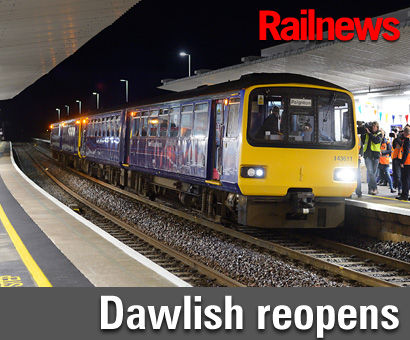A LOCAL train from Exeter St David's to Paignton which has not been able to run since early February was the modest curtain-raiser to the restoration of the Great Western line through Dawlish this morning.
The 05.34 First Great Western service from Exeter duly called at Dawlish just before 06.00, marking the moment when the far south west became reconnected to the rest of the country's rail system once again.
Passengers and local people told how delighted they were: one twice-a-week commuter between Devon and London told the BBC that the sight of trains running along the rebuilt sea wall brought her 'close to tears'.
The town's station had also needed repairs and partial reconstruction. It is being decorated in flowers and bunting by the Friends of Dawlish Station for a ceremony this morning at which it is expected that the Prime Minister will make an appearance.
David Cameron had already visited the site of the 80m breach in the Victorian sea wall after savage storms had partly demolished it in early February, cutting the only rail link between the far south west and the rest of Britain and damaging the economies of Torbay, Plymouth and Cornwall by an estimated £2 million a day.
Mr Cameron said: “This is a great day for the hard-working people of Dawlish, and for businesses and commuters across the South West whose lives have been turned upside down by the devastating loss of their train line. Back in February when I visited the town to see the damage for myself, I promised to do everything I could to get this vital artery back up and running as quickly as possible. I am delighted to say that promise has been delivered today. A promise which says that the South West is well and truly open for business.
“The impact of the extreme weather shows the importance of making our railways strong enough to weather any storm. That is why we announced a £31 million package of improvements and asked Network Rail to examine every option to ensure the resilience of this route, all part of our long-term economic plan to boost business and create more jobs in the region.”
It has been a frenzied eight weeks for Network Rail's army of engineers, who have been working night and day to restore the line, using thousands of tonnes of concrete. They have become a familar sight in the town, whose people dubbed them the 'orange brigade'.
There was a new cause for concern in March when a cliff at nearby Teignmouth threatened to collapse on the line below. Engineers sprayed thousands of litres of water on the cliff to encourage the loose material to complete its descent, so that the debris could then be cleared in a controlled way.
Tom Kirkham, Network Rail’s on-site engineer said: “The only reason we have been able to open the railway today is due to the monumental efforts of all the people who have worked night and day to meet the deadline.
“It has been a genuine team effort, from the guys installing the container breakwater during howling storms, the roped access teams scaling the cliffs to the track workers pushing all the way to cross the finishing line.
“We have had incredible support from outside groups, including the fire & rescue service, the police and the army all who have each contributed enormously. The local community’s support of the ‘orange army’ has been immense as has their patience and understanding. Dawlish, welcome back to your railway!”
The story is not quite complete. Repairs will continue on signalling systems in the area, which are currently operating with temporary equipment, and the sea wall built by Brunel will be completely restored using craftworkers and original stone.
Research is also under way on how an alternative rail route can be provided in the longer term for the far south west. Options include reopening the former main line around Dartmoor between Exeter, Okehampton and Plymouth, or building a new line inland at Dawlish. Such a scheme was first prepared by the Great Western Railway as a capacity boost almost 80 years ago but then abandoned again after the war.
Network Rail chief executive Mark Carne said: “Our army of engineers has done an amazing job of putting back together a railway that was ravaged by the elements. They have overcome every obstacle thrown at them, winning many battles along the way to restore this critical piece of the network, ahead of schedule, and in time for the Easter holidays.
“The biggest thanks must be reserved for passengers and local communities and businesses who have been hugely supportive and patient over the past two months as we worked flat-out to rebuild this vital rail link.
“Our focus now moves to the medium and long-term looking at what can be done at Dawlish to make the current coastal route more resilient and, by the autumn, understand what the best viable relief route might be.”


